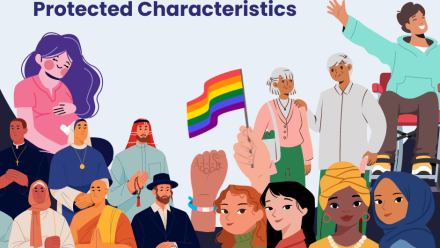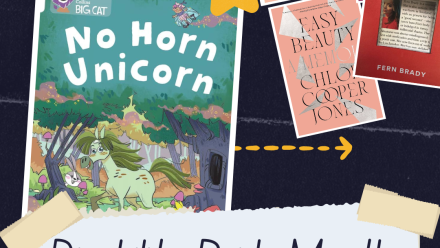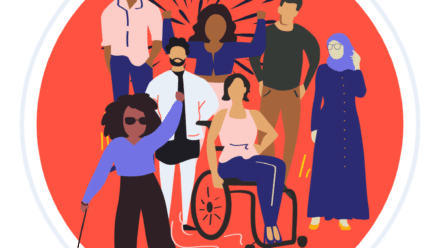Building an Intersectional Workforce Through Inclusive Hiring and Recruitment
21st November 2023 by Scarlett James
Nailing inclusive recruitment can transform your workplace and create a more diverse, innovative and successful team. We’ll dive into the concepts of inclusive recruitment, using an intersectional lens to identify how you can go past buzzwords to take your recruitment to the next level.
What is an intersectional approach to recruitment and talent acquisition?
“When you’re applying for jobs, you see the phrase “we welcome diverse applicants” so many times that it becomes completely meaningless. You start to just filter it out,” says Maya, Director of People at Diversity and Ability.
It’s a classic example of what we often refer to as ‘small print inclusion’; when an organisation’s acceptance of diversity is just a footnote addition.
Let’s go through an example of what ‘small print inclusion’ doesn’t just look like, but feels like.

Imagine that you’re a neurodiverse, non-binary person applying for a job. You find a role that you meet the essential criteria for and think you will be a great fit for. But as always you are nervous about being supported and included in a new company, as you’ve had bad experiences in the past. You’re thrilled to see that, at the bottom of the job advert, the employer has written that they welcome applicants from all backgrounds!
But the application form is a PDF document, with a white background and black text that’s size 10 font. This presents barriers to you, as you struggle to read and fill out the form. So, you ask for the form in an alternative format.
You receive a Word document version of the form, but the formatting is wrong, and it’s now a day before the deadline. You rush to fill in the form, but you get stuck almost immediately when you’re asked to disclose your gender and there are only two boxes: male and female.
One of the things that attracted you to the role was believing the employer when they said they welcomed diverse applicants. But, at every stage beyond that initial statement, you have not been welcomed. You have not been included.
So, what’s the alternative?
Make sure that ‘welcoming’ diverse applicants means a genuine, warm, open-armed welcome, by:
A culture of informed practice
There is no expectation that, as an EDI or HR professional, you can know everything about all lived experiences.
You can’t guess what people need to feel supported and included. But, equally, it’s not enough to leave it to others to work it out for you. Start from the ground up by covering all bases for everyone using a method founded in universal, inclusive design.
Working in this way means demonstrating that, even though you might not share the lived experience of an individual, you are anticipating that individual’s differences and actively working to include them. And, crucially, you’re doing so without them having to ask.
So many of these changes are small shifts to your processes that are low cost and low effort but have a high level of impact on your applicants. For example, providing every applicant with interview questions in advance and offering alternative ways for people to submit their applications, in video or audio format for example.
Similarly, Helen Dobson, Citizens Online Managing Director, spoke to us and said ‘We would recommend including essential digital skills in job specifications, recruitment advertising, interviews, onboarding, appraisals and learning and development policies. Highlighting the importance of digital skills to staff both new and old will convey the understanding that digital inclusion is everyone’s responsibility, recognising the barriers and overcoming them together.’
Encourage sharing; don’t expect disclosure
Asking individuals to tick a box and assuming that that box represents the entirety of their lived experience is old news. Intersectionality reminds us that some people won’t have the social capital to disclose every intersection of their identities. For instance, an individual from a second-generation, working-class family may not feel able to disclose that they are neurodiverse, whether that be from a place of shame and stigma, or because they simply feel they are already behind.
Our CEO Atif Choudhury highlights that ‘When you have to do more to survive in the workplace- be it due to misogyny, homophobia, transphobia, inherent disablism, systemic racism- you have good reasons to hold back. If you have to do more in the workplace to get further in the workplace, then of course you’re hardwired to share less; our workplace survival has been dependent on it!’.
By encouraging candidates to share the barriers they face and the adjustments that would help to mitigate or remove them entirely, you move the conversation away from a place of fear and expectation and towards a culture of belonging.
For example, at D&A, we use a digital tool that enables candidates to quickly and easily share their accessibility needs, making the conversations so much easier, for candidates and hiring managers alike. Explore our AXS Passport and how it can move your processes away from disclosure.
Don’t tackle one inequity without tackling them all
It’s not about tackling sexism, then racism, then disability. You can’t discuss any of these experiences in isolation. A box ticked yes for ‘I am disabled’ tells you little about that individual, what support they may or not need, and what experiences they have faced in life.
For example, a wheelchair user who is gay may feel most excluded when spaces aren’t physically accessible and their company’s compassionate leave and family policies assume all couples are heterosexual. However a Muslim with chronic pain is likely to prioritise flexible working for both their high pain days and religious observances, and maybe a prayer space. Both elements of these people’s identities will be as important to them as each other. Tackling disability and not talking about LGBTQIA+ issues or faith, is ignoring these individuals and their whole selves.
Throughout the recruitment process, you need to be persistently demonstrating your commitment to all facets of diversity and inclusion; not just the area that you have to hit quotas for that year. When you are siloing each characteristic, you are still excluding the most marginalised from those groups.

What now?
You’re ready to start making the changes that signal to diverse applicants that you mean what you say. But you’re stuck on what your organisation can do to really embed inclusion within recruitment.
- You’ve got the power; you’ve got the data
Reflect on the stories and experiences of diverse candidates that did or did not get the job, explore exit interviews and employee engagement surveys to find out what you’re getting right and what you’re getting wrong. - Mix it up!
Involve people from diverse backgrounds to be a part of the hiring process. If a hiring panel is composed entirely of people from the same background, they will fall into ‘in-group favouritism’; subconsciously favouring those who are similar to themselves. By having diverse voices within the hiring decisions you will have a variety of experiences and intersections represented and influencing the final outcome. - You don’t have to be an expert!
If you’re intimidated by implementing changes without having lived experience, don’t fret. As a disability-led organisation that prioritises lived experience, you can turn to us to tackle those subtleties and make the changes that best suit your organisation. We provide recruitment reviews as well as inclusive recruitment training aimed at hiring managers, supporting them to make informed decisions.
Engage in intersectional conversations
Don’t stop learning now!
Our free panel series Labels and Legacies: Embracing Intersectionality with Atif expands on all these points, with accessible and engaging advice and insight from industry experts, in an accessible and engaging way. Watch the series on-demand on our YouTube and keep an eye on our events page for more D&A panels, presentations and webinars.


